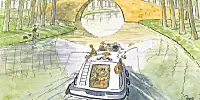-
French crafts in focus: Traditional dry-stone walling
Sébastien Heurtevent is leading a resurgence as an artisan murailler de pierres sèches in Haute-Garonne
-
French building industry taps into the power of hemp
Innovative hemp-based materials are making a comeback in France, offering enhanced insulation and lower carbon emissions
-
Make sense of… boating in France
Summer is almost upon us and many people will be taking to the water once more. We recap what paperwork you might need to get afloat
Make sense of... Bâtiments de France
If you live in a listed building or in an historic area, any significant changes you wish to make to your home may need authorisation from the Architectes des Bâtiments de France

Great care goes into making sure that historic buildings and areas are not spoiled in France, especially in designated conservation areas or close to buildings of special interest. In such areas there may be stricter requirements when it comes to asking for planning permission (permis de construire) or making prior declarations of work (déclaration préalable). And before permission can be given, the plan must be run past an expert with the title Architecte des Bâtiments de France (ABF).
There are several of these based in the capital town of each department, at a Culture Ministry agency called Service territoriaux de l’architecture et du patrimoine (STAP).
Who are the ABF?
An ABF is a state official who trained as an architect and chose certain study modules related to heritage. They are answerable to the prefect.
Each STAP has a chef de service, who is usually an ABF, as well as one or two other ABFs on their staff, along with other professionals, officials and administrative staff.
About ten new ABFs are recruited annually via competitive exams, after which they do a year’s training at a grande école, either the Ecole Nationale des Ponts et Chaussées engineering school in Seine-et-Marne (known as ‘Ponts et Chaussées’ or just ‘Ponts’) or l’Ecole de Chaillot in Paris.
Precursors involved in protecting monuments have existed since the early 19th century, but the ABF role was created in 1946. Their main mission is to be responsible for the maintainance of important built heritage in their area and policing respect of heritage planning rules.
When are they consulted?
They must be involved when work is planned on listed buildings, which refers to a designated monument historique, either classé (structures of national importance, such as monuments) or inscrit (regionally important buildings, usually private homes).
The ABF may also be consulted when work is planned near a listed building or in other sensitive areas, as well as when new construction (or demolition) is planned in these areas.
They are also consulted when listing of a building is considered, while for owners, it’s a good idea to contact them before installing solar panels or satellite dishes within a conservation zone.
Depending on the nature of the building or area, the ABF’s opinion may be binding on local authorities, or just consultative.
For work on important monuments they may have a hands-on role in supervising restoration or repair, notably for national state-owned buildings; however, when it comes to the public they are most likely to play a role in granting permission on behalf of the state. If you wish, you can arrange a meeting with one for free advice at their premises (do an internet search for your department’s STAP to find its address and telephone number).
What kinds of area are concerned by ABF permission?
An ABF is consulted for work on buildings in a 500m perimeter of a classified or listed historic building, or in some cases a larger area within its ‘field of vision’ (as defined by an ABF, with approval from the mairie).
Similar notions include secteurs sauvegardés (safeguarded sectors), which often refers to historic town centres with plans in place to preserve their character, or certain zones designated ZPPAUP or AVAP – an ensemble of buildings or a district heritage interest. They may also be involved where work is planned on ‘protected sites’ such as certain parks and gardens listed under the Code de l’environnement.
If in doubt whether your home is in such an area, your local mairie should have information (buyers planning to renovate an old property should ask the notaire before signing the compromis). Maps may also be available via the website of the Direction régionale des affaires culturelles for your region.
How do I apply for ABF permission?
You do not need to do it directly – you apply for the relevant permission via your mairie and the mairie then passes the dossier to the ABF, who may want to visit to inspect the site.
Note that requirements to submit planning applications can be stricter in protected zones and/or for listed buildings, as compared to ordinary buildings – for example, even small new constructions of less than two square metres may require a déclaration préalable and any demolition will need a full permis as work may affect the structure of the interior.
You will usually need to take particular care with matters like colour and material if replacing windows or doors.
Planning applications through the ABF take up to four months, in addition to the local planning authority’s maximum two-month timeframe. If plans are not to their satisfaction and you need to resubmit them, you start the cycle again – so when submitting initial plans, find an architect with good knowledge of what detail is required or who can consult the ABF in advance.
Applications for financial aid
One of the ABF’s jobs is helping people to apply for financial aid for restoration work on historic buildings, and to help plan the work to make sure it is done respecting the building and its surroundings. Notably they may recommend or validate applications for grants and tax relief from the Fondation du Patrimoine.
The image here was drawn by artist Perry Taylor.For more of his work see www.perrytaylor.fr
























